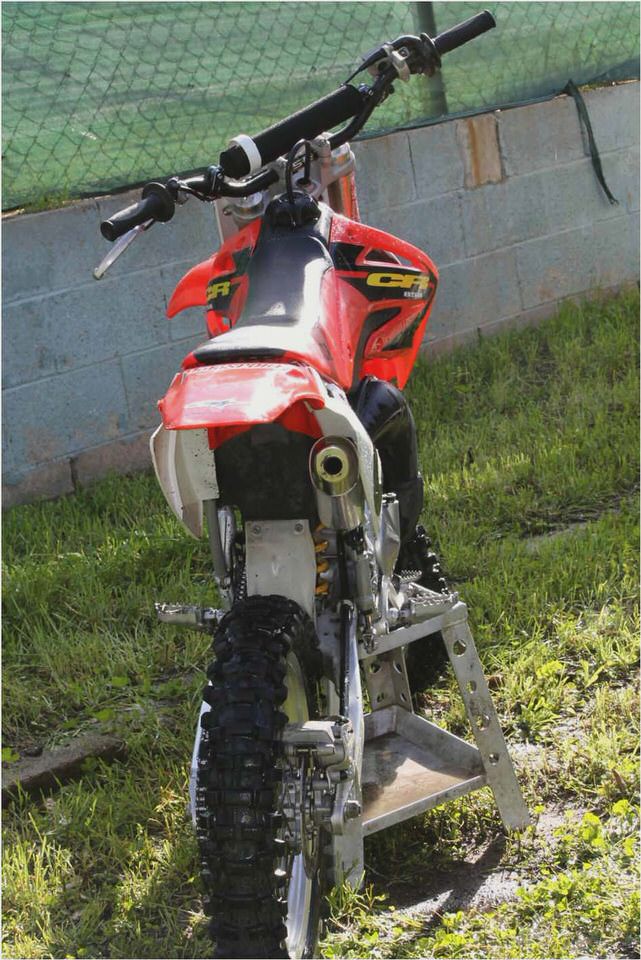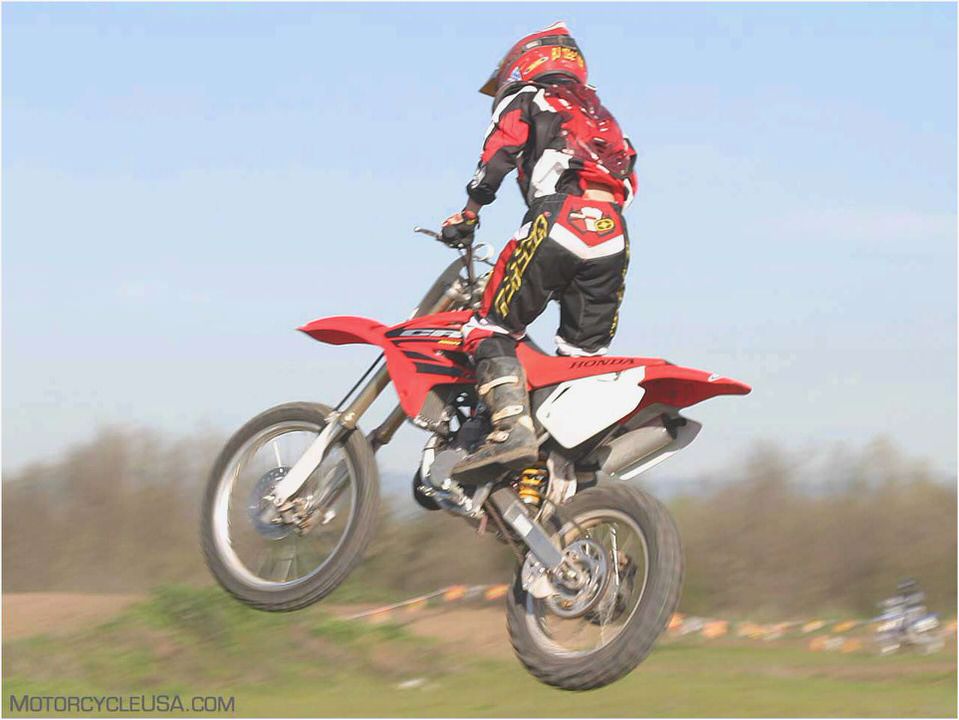
2004 Honda CR85R Expert
As a manufacturer, Honda is meticulous about building excellent bikes. Sometimes though, they tend to take their own sweet time doing it. When a trend arises in the industry, the winged logo has become notorious for showing up late when introducing their version. Peep the evolution of the class leading CRF450R.
Yamaha dominated the big-bore four-stroke class for years, and the only substantial evidence of a possible red entry were rumors and innuendos. Creating the CRF certainly was not a rushed job and when it finally emerged from the engineering department, it won nearly every MX shootout in its first year. The CR85R Expert took a similar path as the CRF450R, albeit on a lesser stage.
The level of performance in the 85cc wars was raised in 2001when Kawasaki, who has been a class leader in the 80cc division, upped the performance ante by increasing displacement on their KX to 85 cubic centimeters, the limit for engine size in the junior division. The following year both Suzuki and Yamaha upped their 80cc models to match the size of the Kawi. Declining to play the role of a lemming, the CR was still displacing just 80ccs.
Honda, like always, waited and took their time refining their machine before releasing the latest adaptation in 2003. The venerable CR80 received a 4.7cc increase in displacement, making it an instant contender. For 2004 they’re hoping to offer a race weapon that is not only as fast as the rest of the bikes in the junior class, but the best one as well.
According to our group of 85cc testing gurus, Honda accomplished this by not only making the it competitive, but by creating a bike that runs better in stock form than many tricked out race machines.
Wheelie inducing power is only a twist of the wrist away on the CR85R
We tested the CR85RE (Say it along with us, E is for Expert) model. This bike is similar to the standard CR85R except that the Expert features a 19-inch front wheel, a 16-inch rear, and a longer swingarm. These components enhance the bike’s ability to handle the rigors it must endure on the motocross track as well as raising the seat height to accommodate growing young racers.
The larger wheels provide exceptional traction, better big-air landing capabilities, and most importantly, better stability at track speeds.
While a select few of the chassis components have been upgraded on the CR85RE the power train remains essentially the same. Nestled in the tubular steel frame is an 84.7cc liquid-cooled, single cylinder, two-stroke engine with a bore and stroke of 47.5mm x 47.8 mm and 8.4:1compression ratio. The result of the square bore and stroke configuration is a mill that revs faster and produces the bulk of its power in the middle and top of the powerband.
This is great news for competitors planning on going with the Honda.
Pumping the air/fuel mixture to the cylinder is a 28mm piston-valve carburetor attached to the industry standard reed-valve induction. This system provides extremely accurate throttle response on the track.
Mason Watson digs in around a high-speed berm. According to Watson the suspension is excellent on the CR85R.
According to our test crew, the little powerplant not only feels strong up top but it just might be the best in its class. Too bad we couldn’t get all the 85s on the Rogue Valley MX track for a comparo this time around but we’ll make sure it happens in 2005 so there’s no guesswork.
It’s really fast. Maybe not as much down low, but once you get the rpm up it’s really fast on top, said 11-year old 85cc Oregon State Champion William See. It’s a lot faster than my Suzuki.
All of our testing grommets heaped praise on the CR85R for its top end power. Furthermore, it seemed as though once they found the middle of the powerband, they realized Honda is in a class by itself.
Once you find the meat of the powerband, the bike is really quick, said Ian Martin an 85cc specialist. It just pulls hard and it seems like it takes a while until you run out of power. But it, like, bogs when you try to get on it out of a corner.
Despite all the initial high praise, it appears not all is perfect on Big Red’s little two-stroke. Last year’s model was criticized for a tendency to bog down off idle and apparently Honda was unable to remedy the problem. To insure they got maximum performance from the CR our testers had to keep the revs up on our mini ripper. As we discovered with our 2004 KX85 test bike, this is not unusual for the 85cc class.
Some gearing changes and time spent dialing in the jetting for your particular needs and the lack of off-idle performance should be history, along with the competition.
William See flogs the CR85R Expert around the MX track.
I like the bottom end of my Suzuki better, said See of his race-ready RM85. The Honda has to be revved a lot to keep it in the powerband, but once it gets going it’s really fast.
The top end hit of the Honda was certainly a hot topic of conversation for our test riders. But, the one aspect of the CR85R that stood out more than any other during our testing sessions is Honda’s ultra-smooth clutch and close-ratio six-speed transmission. Known for their attention to detail Honda didn’t disappoint.
Smooth lever actuation and effortless shifts had our young test group gushing about the CR’s refinement.
I generally don’t use the clutch when I’m racing, divulged Martin. On my KX I have to rock it back and forth a little to get it to go, but on the Honda it was perfect. It’s sooo smooth, the clutch was real buttery.
Slowing the CR85R is a snap thanks to a single disc up front and a single disc in the rear, both of which are engaged by twin-piston calipers. Honda won big points with our testers for a set of impeccable stoppers. When the lever is actuated the binders respond immediately, allowing riders to go deep into corners before slowing down.
Furthermore, neither rider experienced any brake fade throughout a full day of testing.

Ian Martin flows through the whoops section as the CR85R suspension soaks up the RVMX bumps.
We watched in amazement as these youthful pilots plowed through whoops sections and skied over doubles and fat table tops at the test track. The 37mm fully adjustable leading-axel Showa cartridge fork with 10.8-inches of travel suspends the front end of the bike while a pro-link adjustable Showa single-shock with 11.4 inches of travels holds things together at the rear end.
The suspension is really nice, said Seed. It works really good going through the whoops sections. I don’t think I’d do anything to it if I were going to race it.
It feels pretty good for my size the way it is now.
Martin also thought the suspension was excellent in stock form and found railing corners was a breeze. It handles really good going in and out of corners, explains Martin. Sometimes, bikes will try and buck you off when you go through rutted sections, but the Honda worked really good and stayed planted in the corners.
The elevated Expert version of the CR85R rides higher for kids who are growing fast but have not yet acquired the necessary skill to hop aboard a 125. On the standard model, the seat height comes in at a diminutive 32.8 inches while the expert model stands at 34.5 inches, thanks to the taller tires and extended swingarm. While our riders had little problem riding the bike, coming to a stop made it and our vertically challenged riders look like a two-wheel version of the leaning tower of Piza.
However, our pilots cared little about leaning precariously to one side of the bike while waiting for the gate to drop. They were more interested in pushing the CR85R to its limits and whipping the 145-pound bike over every obstacle on the track with the throttle pinned to the stop.
The ony complaints we could nudge out of our testers were a tiny, malleable set of stock bars and a slight bog in the bottom of the powerband.
There was little to complain about, although there were calls for a new set of bars. Both of our riders felt they are way too small for any serious competitive riding and would benefit a great deal from a set of Renthals that come stock on the full-size CRs.
At the conclusion of our test, we asked our riders what they would buy if they could race anything. Almost as quickly as we asked the question each tester responded with one word, Honda. It seems the top end pull along with the refined components like the clutch, transmission, and brakes were big winners with the 85cc group of riders.
With a price tag of $2,999, the CR85R Expert actually comes in below the RM85L, but is 100 bucks more expensive than the Kawasaki, and $50 more expensive than the Yamaha YZ85. However, for the package Honda is putting together we think it’s a remarkable value.
It should also be noted that none of our testers ride a Honda during the racing season. For a group of kids to pick the little Red Flyer over the bikes that have led them to race wins might be a convincing endorsement. Class leader?
Hands down.
Share your thoughts on the ’04 Honda CR85R Expert in the MCUSA Forum .
- Honda CBR1100XX vs. Kawasaki ZZ-R1200 –
- Honda CB400F Supersport
- 2004 Honda Valkyrie Rune Road Test Rider Magazine
- The New Honda Automatic Motorcycle, the Honda DN-01 – Yahoo Voices – vo…
- Taylormade Carbon2 Prototype Moto2 Racing Chassis- First Look

